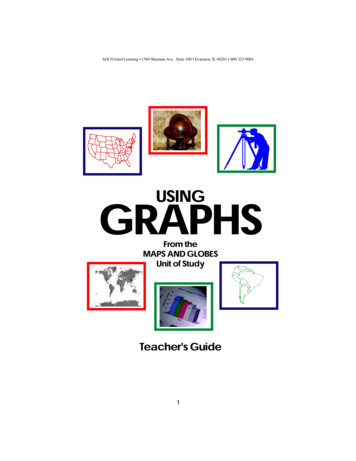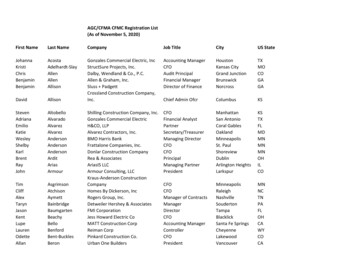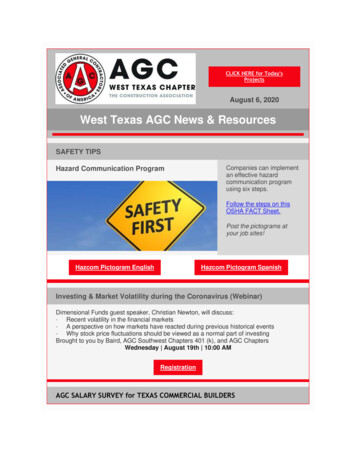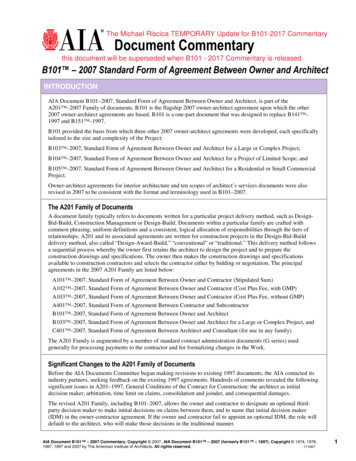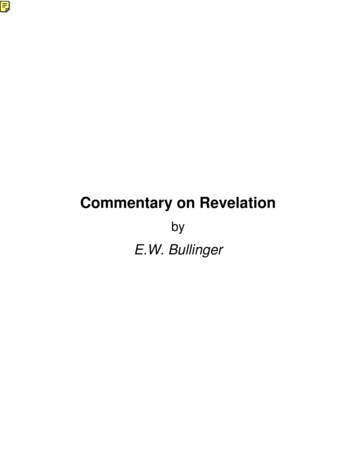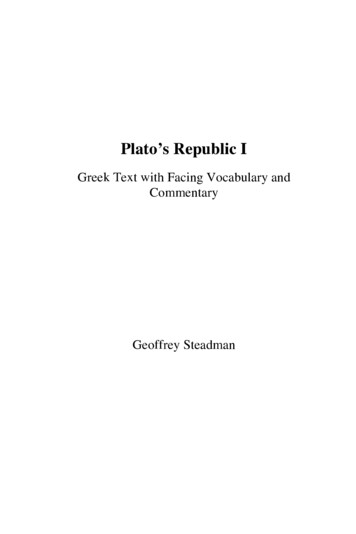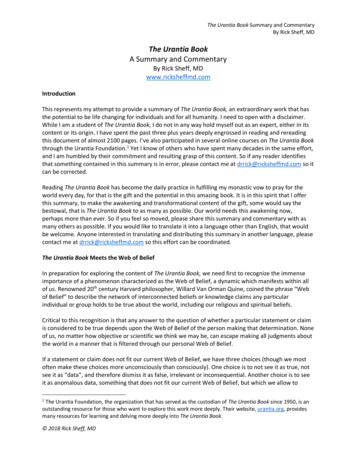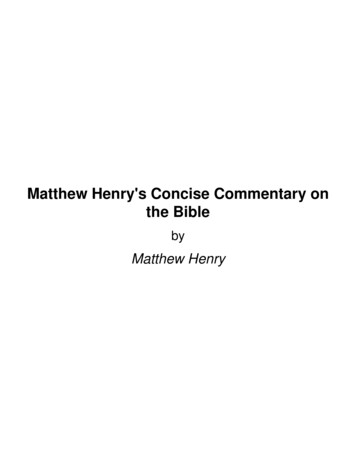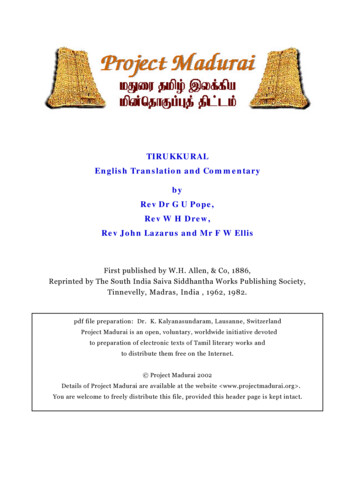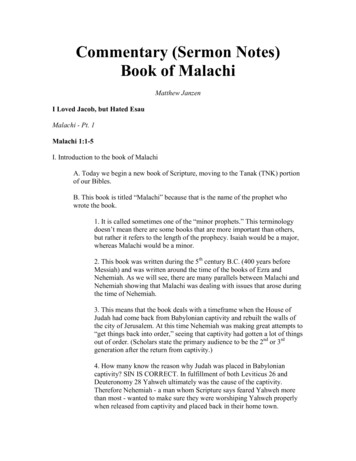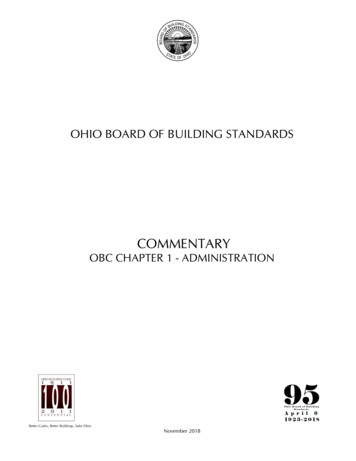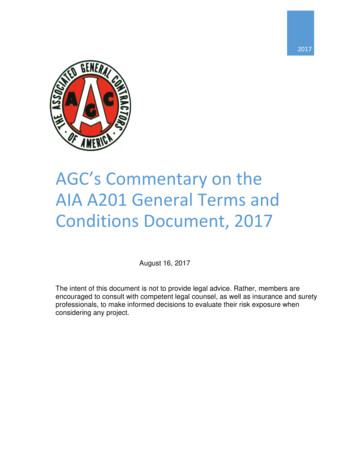
Transcription
2017AGC’s Commentary on theAIA A201 General Terms andConditions Document, 2017August 16, 2017The intent of this document is not to provide legal advice. Rather, members areencouraged to consult with competent legal counsel, as well as insurance and suretyprofessionals, to make informed decisions to evaluate their risk exposure whenconsidering any project.
Article 1Overview of AGC’s Commentary1:The 10-year effort to update the American Institute of Architects (AIA) documents is notwhat we consider a major re-write or update from the 2007 edition, which AGCunanimously voted not to endorse for the first time in memory. For this developmentcycle, the AIA chose not to seek any direct feedback from AGC. Significantly, AGC’sconcerns with the 2007 edition were not eliminated in the 2017 edition.2Overall, the basic premise that the Architect serves as the Owner’s watchdog over theContractor remains. The Architect continues to possess significant authority and rightsover others, but without the corresponding responsibility. The Owner’s mainresponsibility is to pay, and otherwise is largely deferential to the Architect. TheArchitect plays a quasi-judicial role to protect design intent and to act on behalf of apassive Owner. Also intact are the hard deadlines and requirements that a Contractormust strictly comply with or face dire consequences, which starkly contrasts to the oftensubjective requirements given to the Architect, which carry less direct significance to theArchitect’s bottom-line.Upon its release at the AIA convention in late April, AGC put together a dedicated andtalented working group of volunteers from the AGC Contract Documents Forum toprovide commentary to equip AGC members with information regarding the new AIAA201. This Commentary attempts to highlight the most important changes made in the2017 edition with some attempt to consider alterations that Contractors might seek. It isthe intention of the AGC working group on the AIA A201 to provide a further analysisand commentary regarding more fundamental issues that a Contractor might seek inmodifying the AIA contracts regarding language that is not new in 2017, but remains adeep concern for the AGC membership.One of the first things you will notice that is new in reviewing the AIA A201 2017 editionis that the AIA has, in dozens of insertions, adopted use of the Oxford comma. Thischange follows from other standard contracts adopting such an approach and is positivein that there was a well-reported case last year that hinged on the placement of thecomma.3§1.1.8. Initial Decision Maker1 This publication is designed to provide information in regard to the subject matter covered. It is published with the understandingthat AGC and contributors to this document are not engaged in rendering legal, accounting, or other professional services. If legaladvice or other professional advice is required, the services of a competent professional person should be sought.—From the Declaration of Principles jointly adopted by a Committee of the American Bar Association and a Committee ofPublishers and Associations2AGC’s concerns were articulated in AGC Commentary on the AIA A201 (2007 edition). This is attached as an appendix forconvenience.3 See -lawsuit.html.1Preliminary Commentary from AGC of America on the American Institute Architect’s (AIA’s) A201 GeneralConditions Document & Exhibit A. AGC 2017 for Members Only.
AIA has added language stating that the initial decision maker (IDM) “shall not showpartiality to the Owner or the Contractor.”Concern: AIA introduced the concept of an IDM in 2007, which was widely criticized.The 2017 edition does not address these criticisms, and thus, the IDM concept remainsa major concern. The new language is rather telling in that the AIA feels the need tostate that the IDM should not show partiality and glaringly omits avoiding showingpartiality to the Architect, especially when an IDM’s decision implicates design intent.Choosing the Architect as the IDM remains the default, and the vast majority of projectshave the Architect serve as IDM. However, Architects are not specifically trained toperform in this quasi-judicial function.§1.2.1.1. SeverabilityThis new provision clarifies that it is the intent of the Parties that if one provision isinvalidated, the rest of the contract will still be enforceable. This language does not raisea concern.Concern: AIA misses an opportunity in the 2017 edition to include an order ofprecedence clause, which would be critical in an interpretation of contract documents.Wasted time and money is spent on litigating over conflicting terms contained in variouscontract documents and which document should take precedence. AGC endorsesConsensusDocs standard construction contract documents, which include an order ofprecedence. The ConsensusDocs order of precedence clause gives a higher weight todocuments that are created more recently, thereby representing the Parties’ latest andmost refined thinking.§1.6. Notice in General and Notice of ClaimsAIA added new notice provisions in §1.6 which create two separate standards for givingnotice – notice for claims, and notice for things other than claims.Concern: The definition of notice in §15.1 is extremely broad. For claims, notice iseffective only if given in writing and delivered by certified or registered mail or by courierproviding proof of delivery. Contractors who are used to providing notice by handdelivery at the project site will no longer be able to continue that practice withoutmodifying the language of this article. Notice by hand at the project site will no longer beconsidered effective under the new AIA requirements, because no proof of delivery isevidenced (see §1.6.2).Delivery of written notice for issues other than claims may be served by regular mail,certified or registered mail, or courier. It is important to note that the notice may also beserved via electronic transmission only if the Agreement sets forth a method forelectronic transmission. It is likely that the claim notice provision will be interpreted as acondition precedent for the Contractor to maintain its claim rights. Therefore, if theContractor does not use the correct notice procedure, a Contractor’s otherwiselegitimate claim may go uncompensated.2Preliminary Commentary from AGC of America on the American Institute Architect’s (AIA’s) A201 GeneralConditions Document & Exhibit A. AGC 2017 for Members Only.
§1.7. Transmission of Information DigitallyAIA now requires parties to use other AIA contract documents, specifically AIA E203and AIA G202, for transmission of information in digital form and Building InformationModeling; otherwise, all such sharing of information is at the using party’s sole risk.Concern: The 2017 edition marks the first time AIA has impacted substantive riskallocation on construction parties based upon the branding of AIA contract documents.There are other options for creating digital transmission protocols as well as using BIMmodels. A simple change would be to strike out specific reference to the AIAcopyrighted and branded contract document titles or, alternatively, add the term “orequivalent” to the provision’s current language.Article 2§2.2. Owner’s Financial InformationIn §2.2.1, the 2017 edition clarifies that the Contractor has no obligation to commencethe Work until the Owner provides evidence of financial arrangements. This revisionalso allows the Contractor to receive a schedule extension for delay caused by theOwner’s failure to provide financial information.Concern: This provision is problematic as it is vague as to what is required to beprovided. A recommended option is to have the parties agree on what will be providedand then revise this provision by specifically reflecting the parties’ agreement.The new §2.2.2 sets forth the conditions for which the Owner must provide reasonableevidence of financial arrangements once the project commences.Concern: Receiving timely financial information is critical for General Contractors. If aContractor requests financial information, they should be able to receive suchinformation. Prior to the 2007 edition, the General Contractor had a clear right to receivesuch information in a straightforward fashion. AIA restrictions to this previously clearright were one of the main drivers in AGC’s unanimous decision not to endorse theA201 for the first time in at least 50 years. The 2017 edition does not adequatelyaddress AGC’s concerns, and invites party disputes over financial information.AIA has added beneficial language that makes it clear that a Contractor can stop work ifthe evidence of financial arrangements is not provided within 14 days of the request.However, the Contractor can only stop work on the area affected by the material changegiving rise to the need to show the evidence of financial arrangements. This may soundreasonable on paper, but, if a material change to the contract sum requires the Ownerto provide evidence of the financial arrangements, it may not be clear what work isaffected by the material change, and thus, what work can be stopped.Concern: There is a concern about how the new AIA A201 integrates with other AIAagreements in regard to the establishment of the Date of Commencement that impacts3Preliminary Commentary from AGC of America on the American Institute Architect’s (AIA’s) A201 GeneralConditions Document & Exhibit A. AGC 2017 for Members Only.
requesting financial arrangements. For instance, the AIA A101 creates a default inwhich the agreement’s signature date triggers commencement of the Work unless theparties state otherwise (such as the notice to proceed). Consequently, a Contractor willhave diminished rights and access to request financial information once the contract issigned unless the AIA documents are modified.In the new §2.2.4, the AIA added a provision whereby the Contractor cannot disclosethe financial information received from the Owner to its own lenders.Concern: The new language may be a new trap that leads a General Contractor tounwittingly fall into litigation for disclosing confidential information by sharing relevantinformation to its own lender.Article 3§3.2.4. Claims Subject to a Waiver of Consequential DamagesContractor claims are expressly subject to the mutual waiver of consequential damagesin §15.1.7. This 2017 change clarifies what is a probable contract interpretation underthe 2007 language.§3.3.1. Supervision and Construction ProceduresThe Contractor has a duty both to spot unsafe procedures, AND to specify a safealternative: Contractor is solely responsible for construction means, methods, techniques,sequences, and procedures and for job site safety of such;Contractor is obligated to propose alternative means, methods, techniques,sequences, or procedures if it determines those specified may not be safe;Architect is required to evaluate the proposed alternatives for conformance withdesign intent for the completed construction; and,Unless the Architect objects, the Contractor shall perform its Work using itsalternatives.MAJOR CONCERN: The 2017 revisions represent a major risk shift from the Architectto the Contractor. Does the Architect now have any risk if it specifies a procedure that isunsafe? Another concern is what if the Contractor’s alternatives are contrary to theContract Documents. The language in the new §3.3.1 should be strongly opposed. The2007 AIA A201 edition’s language on this topic was also problematic and unclear.§3.5.2. WarrantyWarranty must be issued in the name of the Owner (or transferable) and start whensubstantial completion is issued for that work, which will be determined by theArchitect’s preparation of the Certificate of Substantial Completion for the “Work ordesignated portion thereof” under §9.8.4.4Preliminary Commentary from AGC of America on the American Institute Architect’s (AIA’s) A201 GeneralConditions Document & Exhibit A. AGC 2017 for Members Only.
Concern: This language may lead to different warranty periods for different portions ofthe work, which is consistent with the prior version of §12.2.2.1, governing the postcompletion warranty obligations of Contractor. This may require a modification to thesubcontract, purchase order, and warranty forms received.§3.7.4. Differing Site ConditionsThe time requirements for a Contractor to give notice has now been shortened from 21days to 14 days.Concern: The Contractor has 1/3 less time to notify the Owner of a differing sitecondition.§3.10. Project SchedulesThe new language recognizes that the Contractor may not be the one to prepare theschedule. The new language requires increased detail, but is more of an outline ofminimal requirements, and is not really a scheduling specification. Also note that§3.10.3 requires the Contractor to work “in general accordance” with the most recentschedule. This language recognizes that schedules are forecasts that should notprevent Contractor work optimization.Concern: §3.10 should be revised in order to clarify that the Contractor may revise theschedule “in its discretion and without prior notice.”§3.10.2. Submittal SchedulesAgain, this section recognizes that Contractor may not be the entity preparing theschedule. The Contractor must provide submittals per the schedule.Concern: The AIA language gives the Architect a free pass on submittal responsedelay if the Contractor misses a submittal by even one day. Note, in your subcontracts,a General Contractor should incorporate submittal obligations to the Subcontractor (andshare the risks if submittals are late from the Subcontractor).§3.12.10. Contractor Submitted Design ElementsIn §3.12.10.1, an Owner and Architect can rely upon the adequacy and accuracy ofdelegated design, but the term “completeness” for services performed by a Contractor’sdesign professional has been eliminated (the AIA B101 Owner/Architect Agreement hasnever required the Architect
16.08.2017 · AIA A201 General Terms and Conditions Document, 2017 August 16, 2017 The intent of this document is not to provide legal advice. Rather, members are encouraged to consult with competent legal counsel, as well as insurance and surety professionals, to make informed decisions to evaluate their risk exposure when considering any project. 1 Preliminary Commentary from AGC of America on the .
